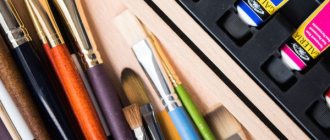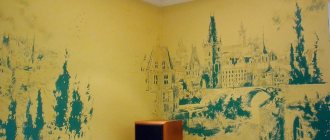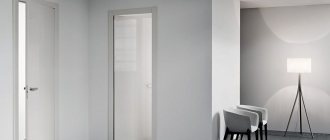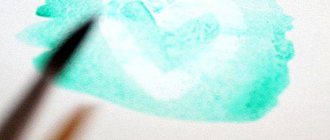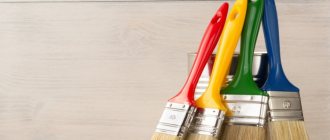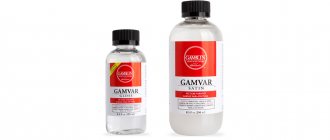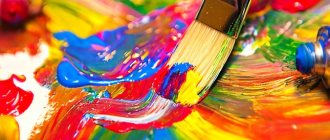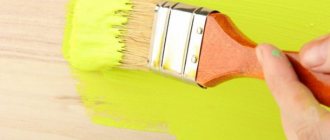Acrylic paints are quick-drying paints that can be applied straight from the tube, unlike oil paints or watercolors. They are very practical to use, bright, and also have a wide range of textures, colors and consistencies.
Acrylic paints are also fairly inexpensive, making them ideal for covering large areas. Because these paints are opaque and dry quickly, mistakes can be easily corrected. All you need to do is apply another coat to the slightly dry paint. They can be used to paint almost all surfaces, and after drying they become waterproof. Moreover, they can be mixed very beautifully
Thanks to its dense texture, acrylic mixes on canvas almost like oil paints. Also, since after drying the hardness of acrylic resembles a plastic surface, the paints are ideal for multimedia painting. But before you start painting, you need to be familiar with acrylic painting techniques.
We'll start with the set of tools you'll need and then introduce you to basic acrylic painting techniques. In this article, you will learn about mixing paints, how to prevent paints from drying out prematurely, and much more.
Acrylic brushes
You should have several different brushes, both in shape and size.
The photo shows the four main brushes used for acrylic painting. Acrylic brushes are typically made from synthetic materials and are suitable for a variety of paints. Please note that brushes for oil or watercolor painting cannot be used for painting with acrylic paints.
You should have several different brushes, both in shape and size. You will soon find out which brushes suit you best, but for the first time you should buy these four brushes. The Filbert brush is a great all-around brush that comes in straight or round shapes.
Getting started - preparing the palette, brushes and paints
To properly prepare your workplace and choose work clothes, you need to know the features of acrylic. When dry, it becomes water resistant. If the drops get on your shirt or on a wooden table, it will be impossible to clean them. Therefore, before starting work, you should put on an apron, wrap the table with cling film and cover the floor with thick paper. If acrylic does get on clothes or furniture during work, try to quickly wash the stain with water or fill it with solvent.
For work you will need the following materials:
- base: paper, cardboard, plywood or canvas;
- set of acrylic paints;
- thin and thick brushes;
- palette;
- glass of water.
For beginners, it is better to take thick paper with a rough texture or white cardboard as a basis: it is easier to draw on them. Having mastered the basics of acrylic technique, you can move on to canvas, wood and other materials.
If the painting surface is a little dark, prime it before starting work. Art and construction stores sell special white acrylic primer. Apply it evenly to the surface with a wide brush and let it dry completely before painting.
Acrylic paints are sold in individual tubes and in sets. For beginners, a set of 12 colors is suitable. It’s worth buying an additional jar or tube of white acrylic: this is the most popular color, it runs out earlier than others. For specific surfaces (fabric, wood, glass, plastic), it is worth choosing the appropriate set: the type of paint should be indicated on the box. Any paints are suitable for drawing on paper and white cardboard.
For those who are just learning to paint, it is recommended to choose brushes made from squirrel fur as a material, although brushes made from fox fur are more common on sale.
Palettes for acrylic paints are sold in art stores. Most often it is a white plastic board with a hole for your fingers. This palette is easily washed off from paint that has not had time to dry. Sometimes palettes are made of plexiglass: they are in no way inferior to plastic ones, but are heavier in weight. You can make your own palette from scrap materials (even from a disposable plastic plate).
Before starting work, put a little paint from each jar on the palette. To make it convenient to mix colors, artists place white paint in the upper left corner, warm shades (yellow, orange, red, brown) along the upper border of the palette, cool colors (green, blue, purple) along the left border. It is better to lay out black paint after blue or purple.
Artistic brushes differ in size, shape (round or flat), composition (synthetic or natural), and hardness (bristles and synthetics are stiffer than ponies and squirrels). Since acrylic paints are dense and heavy, medium-hard synthetic brushes hold them better.
Beginner artists should stock up on 3-4 brushes of different sizes. A wide flat brush is convenient for painting the background. Use a wide round brush to make textured strokes. Medium brushes are useful for painting most objects, while thin brushes are useful for drawing details. High-quality round brushes, even large ones, have a thin, elegant tip. It allows the artist to change the thickness of the line and move from broad strokes to drawing small details without changing the tool.
Brushes should be rinsed in clean water. Pour water into 2 cups, so that in one you wash off most of the paint, and in the other you completely rinse your brushes. Renew the water regularly as it becomes dirty. Place a clean, dry cloth next to the cups to blot your brushes and remove excess moisture.
To ensure that the brushes last longer and the bristles do not deteriorate, you can purchase a brush washer in which each brush is secured in such a way that it is in the water but does not touch the bottom with the bristles.
What types of acrylic paints are there?
Experiment with different brands of paint to see which ones you like best.
Here we use the "GOLDEN Heavy Body" series of acrylic paints, they have an oily texture and can be diluted with plenty of water. These are acrylic paints of thick consistency and do not contain fillers, thickeners, matting agents or additives that negatively affect the color and properties of the paints. We recommend experimenting with different brands of paint to see which ones you like best. Be careful when thinning acrylic paint with water, do not add too much.
For the acrylic painting techniques presented in this article, you can use paints from any company, provided that they are of a thick consistency.
What to draw
It is better to start working with acrylic with small, simple drawings. It can be a simple still life, landscape or abstract figures on a plain background.
The most expressive using the acrylic painting technique are flowers or landscape elements made with voluminous strokes. The volumetric technique allows you to add texture to petals or sea waves, due to which an additional play of light and shadow appears in the picture and the image looks “alive”.
If you dilute the paint with water by half, it will become transparent and fluid and will allow you to create fantasy tints and flows of shades on the canvas. Such effects look interesting in any work, be it still life, landscape, portrait or abstract image.
But for the first drawing it is worth choosing an object that is not overloaded with details and not too complex in structure.
How to mix acrylic paints
Mixing acrylic paints must be approached very carefully.
Mixing acrylic paints must be approached very carefully. You need to know color theory and the color wheel diagram because mixing paint is an integral part of painting. For example, red and yellow can be mixed to create different citrus tones. And adding a little green, you get brown or burnt umber. A palette knife, plastic knife, or an extra brush are ideal for mixing acrylic paint. Mix your paints thoroughly and remember that some paints dry darker.
Workplace
The drawing technique requires organizing the workplace according to the rules:
- lighting should be diffused;
- the light should fall on the canvas from the left side;
- Under artificial lighting, the shades of dyes on the canvas may change.
Preparing the palette
It is recommended to place portions of primary colors on the palette, including black and white. There should be free space between portions of dyes to allow mixing of shades.
Preparing the surface for drawing
The surface for making drawings must be cleaned, degreased, and a primer applied for an even coating of paint.
Mixing acrylic
Acrylic paint for painting is mixed on a palette. To lighten the basic tone, white is included in the composition; white paint is added in small portions with regular stirring. To darken the base color, black or dark brown paint is included in the composition. Once you have gained basic color mixing skills, you can create complex shade combinations.
How to prevent acrylic from drying out prematurely
One way to prevent acrylic from drying out prematurely is to use water.
Acrylic dries quickly, sometimes too quickly. In order to prevent the paints from drying out prematurely, you need to moisten them with a small amount of water. You can purchase a spray bottle at any hardware store. Also, by spraying a large amount of water you can get a watercolor effect.
Use Gesso as a base
"Gesso" is a white primer that is applied to canvas as a base for acrylic or oil paints.
"Gesso" is a white primer that is applied to canvas as a base for acrylic or oil paints. It should be applied in a thin layer to a non-greasy surface (canvas, paper, wood, plaster, etc.). The primer dries quickly, creating a light matte surface that improves the adhesion of acrylic or oil paint layers. "Gesso" for acrylic is a little different from the usual one, as it contains latex. You can also use Gesso to create the desired texture under the paint.
Secrets of acrylic painting
Why do I paint with acrylic? ⠀
Of course, butter is my constant love. But acrylic is very interesting as a material, and especially now, when the choice of manufacturers is presented so widely. I use acrylic paints to paint on various surfaces: canvas, silk, wood, and I paint walls.
• It is acrylic paints that I take on trips. The created picture dries quickly, it can be quickly sent or taken with you; • Acrylic paints can create stunning textures and can even be combined with oil paints; • With such paints you can paint both impasto (texturally) and create smooth, detailed writing. An example of such a picture can be seen today in my story; • Acrylic can be poured, sprayed, mixed with various pastes; • Moreover, it is convenient to work with at home. And especially in the same space with small children ⠀ Have you tried creating acrylic paintings?
The created picture dries quickly, it can be quickly sent or taken with you; • Acrylic paints can create stunning textures and can even be combined with oil paints; • With such paints you can paint both impasto (texturally) and create smooth, detailed writing. An example of such a picture can be seen today in my story; • Acrylic can be poured, sprayed, mixed with various pastes; • Moreover, it is convenient to work with at home. And especially in the same space with small children ⠀ Have you tried creating acrylic paintings?
A few more secrets from me about this wonderful technique: ⠀
• If we talk about cost, then good acrylic paints can be compared to oil. More watery paints are more difficult to paint realistically, but they are perfect for the Fluid art technique. When I paint my works with acrylic, such canvases cost me no less than oil ones. ⠀⠀
• Translucent (designation is half a filled square) paints are good to use for underpainting - the first layer of the Painting. And also for techniques where glazing is used. With opaque paints (painted square), we can perfectly work with a palette knife and paint the work right away, without underpainting. And also in texture technique with strokes.
• Materials for acrylic technology are also diverse: canvas, paper, silk, wood and even walls in the house. As a rule, I prime wood and silk, but it is important to use special paper - for acrylic and oil. ⠀⠀
• Nowadays modern acrylic paints are very lightfast, but despite this, I recommend varnishing an acrylic painting. Now I'm using matte varnish. ⠀⠀
• In my lessons, I always tell you how important smooth shading is. It will be much more convenient for you to paint if you take two brushes, the first to apply paint, and the second (clean or slightly damp) to remove excess, smooth out contours and soften color transitions. ⠀
• To thin acrylic, we use only cold, clean water and synthetic brushes. And to preserve the remaining paints on the palette between working sessions, cover the palette with film and put it in the refrigerator. ⠀⠀
And what you see here is only a small part of a large amount of information about these paints. I have been working with acrylic for many years and now the art market pleases us with an even larger selection of auxiliary materials, I will tell you about some of them today. ⠀⠀
Mediums and drying retardants
What are they needed for? As you know, acrylic is a quick-drying paint and to handle it you need some skill and experience. In order to outwit this property of the material, they invented a liquid that allows you to obtain smooth transitions and define shading more softly. But when I first used it, I didn’t like the drying retardant - the paint became too viscous, complicating the entire painting process. Perhaps because the Russian manufacturer’s product was not of such quality. The highest quality, in my opinion, is the matte or glossy retarding liquid Sminshke - the drying time is reduced by 50%. A clean brush is moistened with the retarding compound. Then the desired color of pure, undiluted tint is taken onto the brush.
• Acrylic glossy medium. When mixed with acrylic paints it creates a glossy effect. Enhances transparency, shine and depth of color. If you dilute the medium with paint of any color in a 1:1 ratio and use the “dry brush” technique, that is, lightly move the brush over the surface, you can get a “light antique” effect. ⠀
• Transfer any picture from paper to wood in a quick and easy way. To do this, just apply the medium directly to the surface and attach the picture, smoothing it carefully. After the work has completely dried, you can begin to remove the paper layer of the picture. To do this, you need to wet the paper with a spray bottle, wait 10 minutes, and then remove the entire paper layer. ⠀⠀⠀
• Medium for acrylic paints Daily Art makes it easier to work in the glaze technique when creating flowing effects and color transitions. When using a medium, the consistency of the paint remains the same, that is, it will not drip, will lie well on the surface and will become transparent. When the translucent paint dries, it will create a depth effect. ⠀⠀⠀
• Medium 560 Shmincke - allows you to achieve an imitation of oil paints. Apply 2 parts paint to 1 part medium. This produces bright and rich strokes like butter. We can achieve approximately the same effect if we paint a picture impasto, for example, with a palette knife and high-quality acrylic. In this case, paint consumption will be significantly higher. ⠀⠀⠀⠀
Have you tried painting with acrylic? Share your impressions 
Glaze acrylic painting
Glizal or glazing is a very interesting technique based on applying thin (almost transparent) paints on top of each other.
Glazing is a very interesting technique based on applying thin (almost transparent) paints on top of each other. Using a liquid gel medium is the best and easiest way to achieve a glaze effect. You can also thin acrylic paints with water, but they will be less vibrant and transparent than using a gel medium.
Start by choosing the color you want to cover the area of the painting. In this case we use green. Then mix the paint with a small amount of gel medium. And as soon as you get a homogeneous mixture, apply a glaze layer to your painting.
If you need to take a break...
Acrylic paint cannot be "revived" once it dries, so if you need to take a break, seal the paint in an airtight container to keep it moist. For a short break, you can simply cover the palette with plastic wrap; for a long time - put the entire palette in an airtight container or use a palette knife to transfer individual colors into an airtight container.
How to create soft transitions between colors
The wet-on-wet method is the best way to achieve a smooth transition
Creating soft transitions (blending) is one of the most difficult acrylic painting techniques. First apply a layer of white paint, then use a filbert brush to add color underneath (we're using blue). Next, make quick movements left and right, moving the brush until you get a smooth transition from blue to white. The wet on wet method is the best way to achieve a smooth transition. You can also get a smooth transition on a dry surface. To do this, you need to apply the color, let it dry and then apply another color with a dry brush.
How does Fluid Art work?
The main components for Fluid Art are acrylic paints and thinner. Acrylic paint is mixed with thinner to a fluid consistency similar to liquid honey.
You can add silicone oil to the mixture to create cells, cells that imitate bubbles or holes, as well as a variety of metallics, sparkles, gold leaf, solutions for creating cracks, etc.
Then the mixture of colors is poured onto the canvas and carefully tilted in different directions so that the paints mix and form a pattern. The image will depend on the application technique and your idea.
As a result, you will create a unique work of art that will be impossible to replicate exactly again. Fluid Art provides endless possibilities for imagination: color combinations, various additives and fillers, and, of course, various techniques.
Applying paint to a previously dried liquid layer
It is best to use this technique when the previous liquid coat of paint has already dried. Fill your brush with paint (we're using dark purple) and paint a shape on the previously dried orange layer.
You've probably seen that acrylic paints are incredibly easy to use and are a good alternative to oil paints. In addition, they are odorless and can be washed off hands without the use of solvents.
Preparing the palette
The palette is used to mix colors and obtain new shades before applying paint to the canvas. Even a ceramic plate with a glossy surface can serve as a palette.
But it is better to use a special artistic palette made of white plastic. It must be clean and have a smooth surface.
On this basis, the shades of the spectrum are clearly visible and can be easily mixed with a brush.
To ensure that the paint sticks less to the palette and is easier to wash off later, the product should be sprayed with water from a spray bottle before work. The same can be done with paint applied to the palette. This technique will allow it to remain wet longer and maintain plasticity.
After work (and sometimes during it, if the palette is too dirty), the tool must be washed. If the paint has not hardened too much, this can be done with water.
And dried ones will have to be removed using a solvent.
